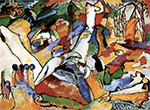
Illusions That Give Joy
"To your land of unbelief, where the dead do not speak, where every
man is wise, and alone--and at peace!" (Tales 33).
Joseph Conrad's "Karain: A Memory" (1897)
Joseph Conrad's "Karain, a Memory" (1897), in Tales 8-42
- is the narrator’s nostalgia for the Eastern Archipelago tied more to the place or the people?
- does the narrator believe that nostalgia for the past can be effectively recovered and conveyed to others?
- does the narrator’s initial description of Karain’s domain (9) provide us with an objective or subjective description of the place and people?
- is the narrator’s perspective authoritative—never questioned?
- is Karain, who suspiciously casts an “illusion of unavoidable success” (10), in fact a capable leader of his people?
- can we explain away Karain’s visions of Pata Matara’s sister?
- how should we characterize Karain’s fateful, violent decision? Is he motivated more by honor, justice, equality, or desire?
- does this story ultimately validate the supernatural, or dismiss it as either fabrication or guilt-induced hallucination?
- does Karain’s belief in the supernatural bring him peace?
- which of the characters genuinely see Karain as a friend?
- which one of the characters believes it a moral act to lie in order to help a friend, and comes up with a charm to give Karain to ward off that which pursues him?
- do the sailors ultimately see Karain as more similar to them than he is different?
- is European culture ultimately presented as superior to that of Malaysia and the Philippines?

Study to Composition, II (1910)
Wassily Kandinsky
Dr. Paul Marchbanks
pmarchba@calpoly.edu
![]()
